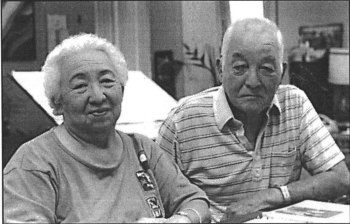Violet and Takeshi Hirata

Tsunamis Remembered: Oral Histories of Survivors and Observers in Hawai‘i
Life history interviews with individuals who witnessed and survived tsunamis-particularly the 1946 and 1960 disasters on the Big Island of Hawai'i. Thirty individuals-mostly residents of Hilo and Laupahoehoe-recall their experiences before; during, and after the 1946 and 1960 tsunamis which were arguably the most destructive natural disasters in modem Hawaiian history.
Violet Okino Hirata was born September 29, 1925 in Hilo. She was the third of seven children born to Yoshio Okino and Masako Kayano Okino, who owned and operated Okino Hotel on 482 Kamehameha Avenue. The hotel was started in 1913 by Yoshio's father, Yoshimatsu Okino, an immigrant from Japan. Violet Hirata grew up in family quarters in one section of the hotel. Along with her two older sisters, she helped her parents in the hotel dining rooin, serving food to customers and clearing tables. She also helped take care of her four younger brothers. She attended school until her sophomore year, when she dropped out to help her parents in. the hotel. Okino Hotel was demolished in the 1946 tsunami. Hirata and the family managed to escape the waves by fleeing in back of the building--away from the ocean--toward the Hilo Gas Company gas tanks. Her brother, George, became trapped in the debris and was later rescued. A guest of the hotel died that day. Hirata's parents later built another hotel on Kino'ole Street, which they operated until 1959. Hirata eventually worked as a hairdresser, and later, for Western Auto. She retired in 1989. She and her husband, Takeshi Hiiata, whom she married in 1949, raised three children and currently have five grandchildren. Takeshi Hirata was born February 8, 1921 in Waiakea Homesteads. His father was employed by Waiakea Mill Company. Hirata attended Waiakea Waena, Hilo Intermediate, and Hilo High schools, graduating in 1939. He then began working at a carpenter's apprentice. During World War II, Hirata volunteered for military service and was a member of the 232nd Engineers and served in France and Germany. After his discharge, he returned to Hilo and began working as a carpenter and maintenance worker for Hawai'i County. As a county employee, Hirata was assigned to one of the crews responsible for cleaning up debris from the 1946 tsunami. After the 1960 tsunami, Hirata worked to construct replacement portable buildings. Mr. and Mrs. Hirata were interviewed in the Pacific Tsunami Museum.
Scope and Content Note
Hilo-born daughter of hotel owners recalls her family's business and clientele. She describes working in the hotel and watching over her younger brothers. In the hotel with her family when the tsunami hit, she chronicles the escape of family members, including brother George who was trapped under rubble, and the demise of a hotel guest. Interviewed with Takeshi Hirata.
A carpenter from Waiakea Homesteads summarizes his family life, schooling, and military service with the 442nd Regimental Combat Team. He describes watching the 1946 tsunami from Hakalau Gulch. As a county maintenance worker, he cleaned up after the tsunami, picking up canned goods and other debris. He was also involved in the post-tsunami cleanup in 1960, salvaging material from Waiakea Elementary School in order to rebuild portable buildings there. Interviewed with Violet Okino Hirata.
Program Note:
This interview is part of the Center for Oral History's project Tsunamis Remembered: Oral Histories of Survivors and Observers in Hawai‘i. Interviews from this project are available in the Center's ScholarSpace open access repository.
The Center for Oral History (COH), in the Department of Ethnic Studies at the University of Hawaiʻi at Mānoa, collects, documents, preserves and highlights the recollections of Native Hawaiians and the multi-ethnic people of Hawaiʻi. It produces oral histories and interpretive historical materials about lifeways, key historic events, social movements and Hawaiʻi’s role in the globalizing world, for the widest possible use.
Please Note: The oral histories in this collection are protected by copyright and have been created for educational, research and personal use as described by the Fair Use Doctrine in the U.S. Copyright law. Please reach out Voices@noaa.gov to let us know how these interviews are being used in your research, project, exhibit, etc. The Voices staff can help provide other useful resources related to your inquiry.
The NOAA mission is to understand and predict changes in climate, weather, oceans, and coasts, to share that knowledge and information with others, and to conserve and manage coastal and marine ecosystems and resources. The Voices Oral History Archives offers public access to a wide range of accounts, including historical materials that are products of their particular times, and may contain offensive language or negative stereotypes.
Voices Oral History Archives does not verify the accuracy of materials submitted to us. The opinions expressed in the interviews are those of the interviewee only. The interviews here have been made available to the public only after the interviewer has confirmed that they have obtained consent.
